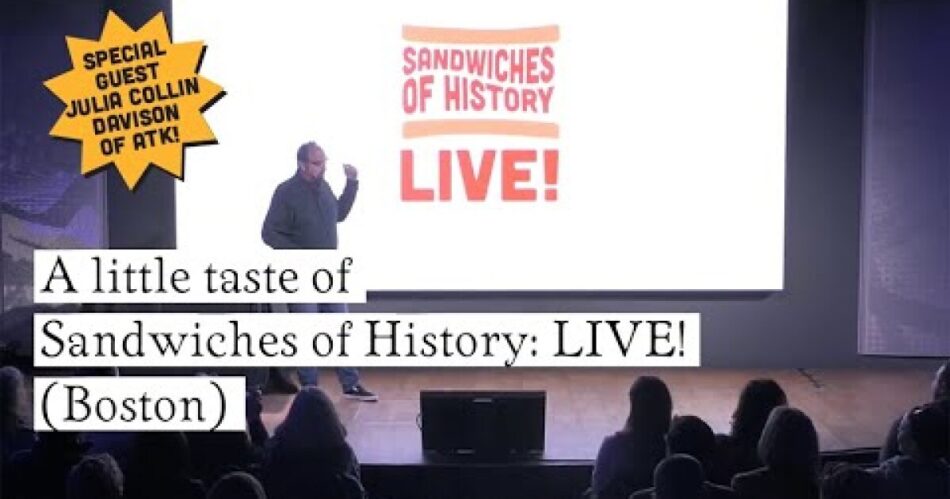SAM DINGMAN: Mark, are you a sandwich guy?
MARK BRODIE: Yeah, I’ve been known to eat a sandwich or two, yeah.
DINGMAN: As have I. As have I. I don’t know about you though. I’m not sure I’ve ever given a whole lot of thought to what makes an ideal sandwich. I can’t say I have. No, again, same. I tend to think of them as more of a handheld protein delivery system than a gourmet project.
But I recently came across a YouTube channel that thinks about sandwiches much more carefully than you or I. It is called Sandwiches of History, and it’s the project of a guy named Barry Enderwick. A few times a week he makes a video of himself preparing a sandwich recipe from his collection of sandwich cookbooks — which, yes, is a thing.
Some of these recipes go back over 100 years. Highlights include such classics as the orange and deviled ham sandwich, the cheese and anchovy sandwich, and something called the “matador delight.”
BRODIE: Sounds interesting?
DINGMAN: Well, if you like chopped ham, chopped chicken, sliced almonds, and chili powder, perhaps you’d have to watch the video to find out if Barry likes it. What he does is he makes the sandwich, tries it, and then gives it a rating. Sometimes he gets an idea to improve the recipe. He calls that a “plus-up” — and then he’ll share that as well.
And I have to say, Mark, these videos are so addictive. It is just really fun and, dare I say, relaxing to watch Barry go on this journey through a kind of silly corner of food history. And he’s actually had enough success with this concept that he is bringing the “Sandwiches of History: Live” show to Tempe center for the Arts this weekend.
So I spoke with him recently about how it all started.
Full conversation
ENDERWICK: Well, I had already been doing a channel called “In the Chips with Barry” where I was reviewing potato chips from around the world.
[CLIP FROM VIDEO]
And my friend Adam, he sent me the PDF of the “Up-to-date Sandwich Book” that was published in 1909. And I was looking through it and I’m like, “Some of these are really odd.”
[CLIP FROM VIDEO]
And so I just thought this would be fun to do.
DINGMAN: Yeah.
ENDERWICK: And I have to eat lunch, so.
DINGMAN: You do have to eat lunch. One of the things I love about the videos is they sort of remind me of — they have, like, a quality of comic strip to them, which, I mean, as a compliment. Yeah.
ENDERWICK: No, I take it as one.
DINGMAN: There’s you kind of, you’re always kind of positioned in the frame in the same way. You’re always wearing a shirt with an interesting pattern. You’re in your kitchen, and you’re always, like, roughly positioned in the same place in the kitchen. So there’s this, like, familiarity to it. And then we go on the adventure of preparing the individual sandwich with you.
[CLIP FROM VIDEO]
DINGMAN: And then we get the payoff of you tasting the sandwich and in some cases, deciding to plus it up.
ENDERWICK: [CLIP FROM VIDEO] “OK, let’s give this cheese and anchovy sandwich a go. It’s actually not too bad. It’s a little salty, but I do want to plus it up a little, though. I’m gonna add a little bit of tomato. And since we already have saltiness with the anchovy paste, just a little pepper. OK, let’s give this cheese and anchovy sandwich plussed up with a tomato that’s been seasoned with pepper, a go. That’s actually quite a bit nicer now. …”
DINGMAN: I have to confess, I haven’t actually made any of the recipes, though I watch the videos mostly because it’s fun to hang out with you for five minutes.
ENDERWICK: Oh, you know, thank you. I appreciate that.
DINGMAN: There’s a way that you approach it that is so natural. … You’re not, like, trying to pass yourself off as some grand authority. Like, one of my favorites is there’s one where you have to caramelize onions, and you realize partway through that you did it wrong.
ENDERWICK: Yeah, yeah, yeah. Very much sounds like me.
DINGMAN: And you don’t beat yourself up that you made them wrong. You don’t fall all over yourself to apologize. You just kind of acknowledge it and keep going. And it doesn’t seem to rob you of any of your joy about eventually eating the sandwich.
ENDERWICK: No, I mean, it’s a sandwich. Why get too upset about it?
DINGMAN: Yeah. I mean, there is something very sandwich about that approach. It’s such an every-person food.
ENDERWICK: Yeah. And what’s great is when I first started up, I did not do plus-ups. I was just, I’m doing the sandwich and here’s a rating and see you tomorrow. And then, you know, most of the sandwiches were falling in this weird zone. They weren’t great, but they weren’t horrible.
And I thought if you just add a couple of ingredients, you know, that we have around today, this might be something we want to make again. And doing that not only, you know, made it more interesting for me. Because now I get to, like, think like, “Oh, what kind of interesting, fun thing can I put in there to make it taste good?” But if you look in the comments section, everyone loves to play along.
[CLIP FROM VIDEO] “I’m gonna plus it up with some Philippe’s mustard. That’s right, from the OG or supposedly OG place in LA sent in by Tristan. Thank you, Tristan. Appreciate it. Supposed to be a really spicy mustard, so let’s go nuts.”
DINGMAN: I don’t know. There is just something so quietly gratifying about seeing you go like, all right, let’s give it a shot. And then, you know, I’m just sitting there watching. I’m like, “I hope Barry loves this. I hope this works out for him.”
ENDERWICK: Thank you. I very much appreciate that. And sometimes it does. Most of the times, it does.
DINGMAN: Let’s talk a little bit about this book that your friend sent you, “The Up-to-date Sandwich Book,” which had these recipes going back to 1909. Talk about some of the more obscure sandwich recipes that jumped out at you when you started looking through this book.
ENDERWICK: One is ridiculous. It’s called the dairy sandwich. … And it quite literally is two slices of Swiss cheese that you butter and press together. There’s no bread. It’s literally a dairy sandwich. … They also add in their oyster sandwich — raw oysters chopped up, mixed with olive oil and Worcestershire sauce, and then put between buttered bread with a lettuce.
DINGMAN: Oh, my God.
ENDERWICK: Yeah. It was a textural nightmare.
DINGMAN: There’s one video that you did where I think somebody sent you the recipe from that one of the police officers in “Dragnet” likes.
[CLIP FROM DRAGNET] “Corned beef, imported Swiss lettuce, Russian dressing, coleslaw, kosher pickle, slice of tomato, mayonnaise, peanut butter, horseradish and a little hot mustard.”
ENDERWICK: Bill Gannon — I did two of his sandwiches. And they were both shockingly tasty. The other one had peanut butter and garlic juice, and it was just like, what? And it actually was quite good.
DINGMAN: So at a certain point, you had the opportunity to write a sandwich book of your own, correct?
ENDERWICK: Yeah, “Sandwiches of History: The Cookbook.”
DINGMAN: As you approached that challenge, what did you want to do similarly to the canon of sandwich literature that you’re so familiar with? And what did you want your own twist? How did you put your own twist on it?
ENDERWICK: What I did is most of these recipes can be a little bit vague. Recipe writing was more art than science for a while there. What I decided to do was adapt the recipes, go through, give guidance where guidance didn’t exist. If they said add anchovy paste but didn’t tell you how much, figure out how much is a good amount to add so that it tastes good and isn’t overpowered by the anchovy paste. So I adapted all the recipes across different years and different cookbooks, and I included one original recipe.
DINGMAN: Would you be willing to reveal that original recipe?
ENDERWICK: Oh, yeah. Basically, it’s a frozen waffle that you, of course, toast up, slather and peanut butter. You can use chunky or creamy, whatever you like. Top it with sliced smoked duck breast, and then sprinkle on top of that cherry Pop Rocks.
DINGMAN: Cherry Pop Rocks. [LAUGHS] That’s a real plot twist at the end. Cherry —
ENDERWICK: Yes, it is. But if you think about it, the nuttiness of the peanut butter goes well with the smoky duck breast. And the cherry goes well with the smoky duck breast. And then you’ve got the waffle as the base, sort of like the neutral party that helps bring it together.
DINGMAN: Do you feel like you have any bigger takeaways about life coming out of spending all this time studying sandwiches and eating sandwiches?
ENDERWICK: I think we tend to get stuck in just thinking things are a certain way, and that’s just how they are. We don’t even think about the possibility that they could be different. Like, I have gotten so many messages from folks that are like, “You know what? I never really thought about, you know, adding something to my sandwich to make it better until I started watching you.”
And it’s not like that’s like I’ve, you know, invented the wheel here. But I think it’s reminded people that you don’t have to just have what is, you can make things a little bit better for yourself.
DINGMAN: Words to live by.
KJZZ’s The Show transcripts are created on deadline. This text is edited for length and clarity, and may not be in its final form. The authoritative record of KJZZ’s programming is the audio record.








